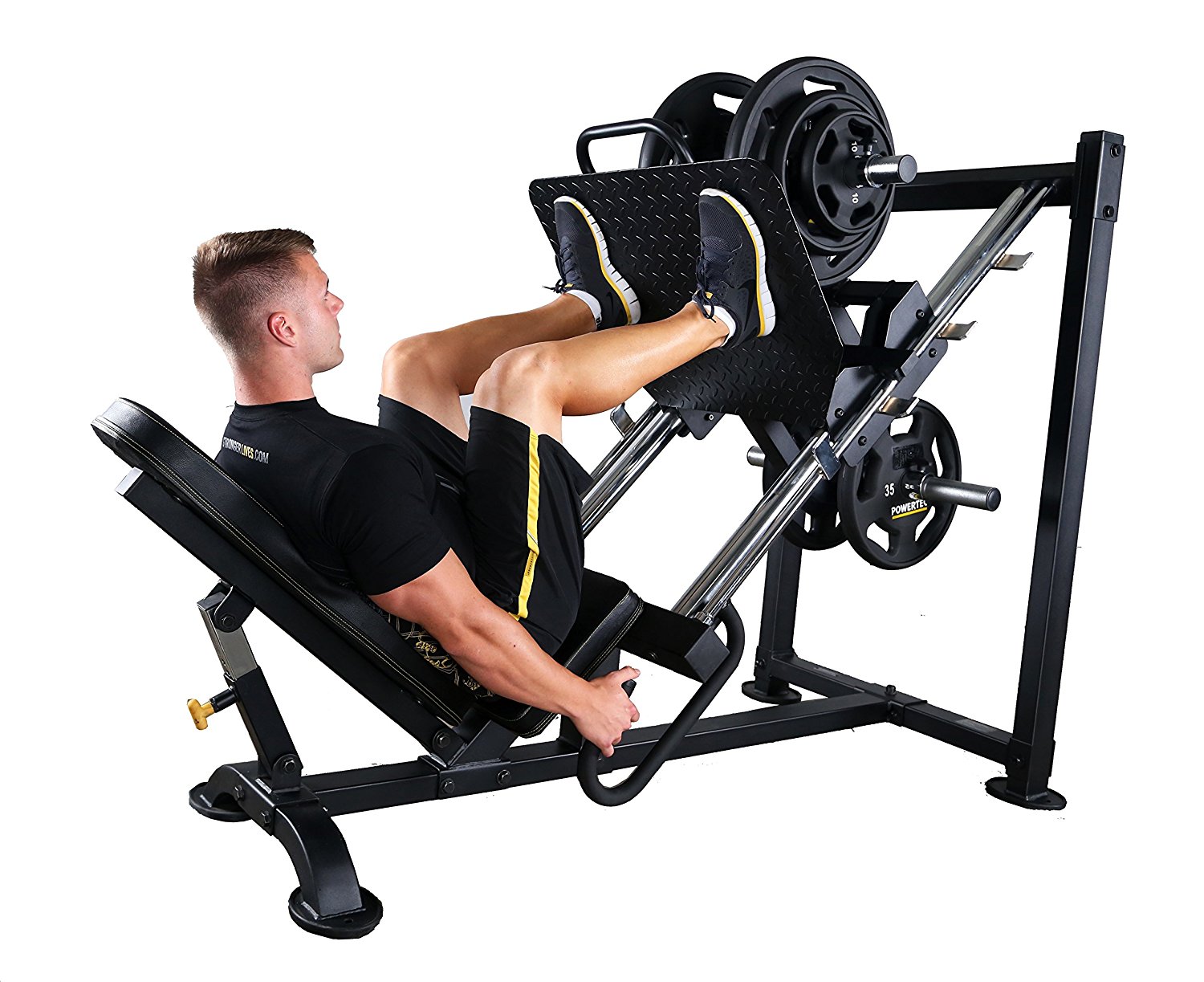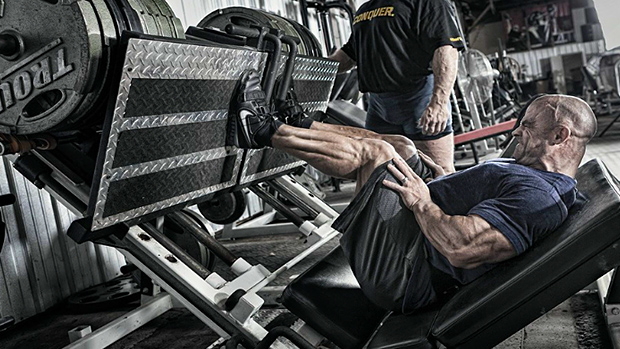The foot press machine may be one of the most dangerous to use, but this article explains how to safely use this machine without the risk of leg press injury.
 Simulator for the bench press feet can be found in almost every sports club, as bench press is an excellent exercise aimed at the development of the leg muscles. It can be used both in the period of the set of muscle mass, and during drying to give relief and definition to the muscles. In addition, it is able to inflate the intensity of training times and for this reason is successfully used in both fitness and bodybuilding, and in functional training.
Simulator for the bench press feet can be found in almost every sports club, as bench press is an excellent exercise aimed at the development of the leg muscles. It can be used both in the period of the set of muscle mass, and during drying to give relief and definition to the muscles. In addition, it is able to inflate the intensity of training times and for this reason is successfully used in both fitness and bodybuilding, and in functional training.
Depending on the setting of the feet on the platform and the amplitude of motion, with the leg press injury in the simulator, you can work out different muscle groups:
- quadriceps;
- inner and back surfaces of the thigh;
- gluteal muscles.
Of course, bench presses lying in the simulator completely can not replace you with heavy squats with a bar, but still it creates a very serious stress for your muscles. Provided qualitative recovery, proper rest, periodization of loads and proper nutrition, this will lead to muscle hypertrophy and an increase in strength in the basic exercises.
After reading this article, you will learn how to do it with your feet, how you can replace this exercise and how to achieve a really serious increase in muscle volume with it.
What muscles work?
With this exercise, you can locally load any muscle group of the lower body.
- The already we put our feet, the more the quadriceps work.
- Another variant of the bench press is suitable for girls: put your feet wide with the leg press injury with your legs, unfold your feet outwards, and most of the load will go to the inner surface of the thigh and buttocks.
- There is also a version of the bench press for the buttocks: we put our feet on the very top of the platform, the legs are slightly wider than the shoulders, the feet are slightly deployed to the sides. Such an exercise will perfectly load the buttocks and hamstrings, in such an amplitude it is easy to “catch” the stretching and contraction of the muscles we are interested in, and the sensation movement itself will represent some combination of Romanian traction and leg bending sitting in the simulator.
- In addition to the classic bench press at an angle, there is also a vertical bench press. With a vertical bench press, the platform is strictly perpendicular to the athlete’s position. The motion is carried out in a sufficiently short amplitude. This allows you to isolate the lower part of the quadriceps (droplet muscle) in isolation, which will make the leg more bulky in the lower part of the thigh, closer to the knee. In Russia, this simulator has not yet received a special distribution, and it can only be found in fitness clubs of the premium class.
- However, nothing prevents you from doing practically the same thing in a regular Smith simulator, for normal execution you need only the help of an experienced partner who will open and close the safety mechanisms.
- There is also a horizontal bench press. Working in this simulator, you increase the amplitude of motion by several centimeters. In this and the peculiarity of this simulator: you perform a huge amount of work without using a huge weight. Also this version of the exercise perfectly studies the lateral head of the quadriceps, making the hip visually larger and muscular.
In all these variations, the stabilizers are the muscles of the press and the extensors of the spine. Without a strong loin and muscles, the bark will hardly be technically correct to perform bench press with decent weight.
Also, the press bench presses perfectly for the calf muscles. The technique of the exercise is exactly the same as in the block simulator for working on the calf standing, where the trapeze athlete rests against the roller. There are no special differences between these two exercises, choose the option that is more convenient for you to do.
Benefit and harm exercise
Foot press in the simulator – the second after the classic sit-ups with a barbell exercise for building strong and massive legs. With his help, you can perfectly develop the musculature of the legs, without creating excessive axial load on the cervical and thoracic spine.
Benefit
It is much easier for most athletes to focus on leg work when doing a press with their feet than with squats with a bar on their backs or on their shoulders. We all remember that the developed neuromuscular communication is simply necessary for muscle growth and progress in force indicators. So to give muscles a tonus and a set of muscle mass, the leg press injury will do just fine. Of course, heavy base squats are equally important for this, and you can not forget about it. Especially, if you are a beginner, and your priority task is to create a certain power base in basic movements with free weights. Without this, moving on will be much more difficult. Squatting, we raise the hormonal background and set the preconditions for progress. By doing this exercise, we begin to “polish” what was asked by squats.
To give the muscles of the legs a relief and rigidity, experienced athletes can be advised to press in the superseries with other exercises. For example, sit-ups, attacks with a barbell and leg extensions sitting in the simulator. Such a complex load on the quadriceps will lead to a strong pampa, which will allow to have raised and worked legs even when the fat level in the body exceeds 12-15%.
Traumatic danger
Potential bench press in the simulator is one of the most traumatic exercises that you can perform in the gym. Perhaps, it can be put on a par with the deadlift and squats with a barbell. However, this question is directly related to the technique of performing the exercise and the excessive egocentrism of the athlete.
Many athletes perform the exercise as follows: weigh a huge weight (from 500 kg and above) and perform 3-5 repetitions with an amplitude of not more than 15 centimeters. Remember, you probably have seen this many times. Do this not in any case. Sooner or later, such an approach to strength training will lead to serious leg press injury, and you risk permanently tying with sports.
In the bench press for us, the feeling of the muscles is paramount. Working in such a small range of repetitions, this can not be achieved – a refusal will come sooner than you will achieve blood filling of the muscles. In addition, in the press with our feet, the amplitude of the movement is important to us, and these 10-15 centimeters are clearly not enough. Legs need to be lowered as low as you have enough stretch marks, without taking the coccyx away from the simulator.
Crazy working weight is also not needed. Work with a weight that you can make from 10 repetitions. If you are already an experienced athlete and are technically able to perform press rigging with heavy weight, use knee bandages to minimize the risk of injuring knee ligaments.
Contraindications
There are a number of situations in which it is worth not using the exercise in the training process:
It is not recommended to perform this exercise for athletes who have suffered injuries to knee joints and ligaments. Work in this trajectory, and even with a lot of weight, can lead to a recurrence of trauma and serious complications.
In addition, the press presses the load on the lumbar spine. Not as strong as squats and deadlifts, but enough to aggravate your problems. Therefore, in no case should such a load be done by athletes with hernias or protrusions in the lumbar spine.
With scoliosis, lordosis or kyphosis – you can perform this exercise, but very moderately, with small scales and under the constant supervision of a fitness instructor. It is recommended to use an athletic belt – this will slightly relieve the load from the waist. However, do not tighten it too tightly – during the leg press injury by feet we need a smooth and unhindered breathing.
Variations of loads
The load when performing the bench press with the feet can be varied by different ways of setting the legs.
- We put the feet in parallel and narrow-footed legs turns into an isolated exercise for the quadriceps, the resulting muscles of the thigh and the buttocks cease to participate in the movement.
- If you put your feet at the very bottom of the platform, we will increase the amplitude of the movement, and the quadriceps will perform even more work.
- If the feet are turned outward at 45 degrees and legs are set wide, the feet leg press injury will load the inner surface of the thigh, the hamstrings and the gluteus muscles.
- With the feet for the buttocks, the legs should be placed at the very top of the platform. The blood flow and burning sensation is guaranteed.
- Use different options and do not forget about the principles of the periodization of the load. Then you will get proportionally developed and aesthetic muscles of the legs.
Technique of doing the exercise
Regardless of which version of the exercise you are performing, the basic principles and techniques of doing the exercise are always the same, so let’s discuss the common rules for all options, how to do the bench leg press injury:
- We are in the gym for the bench leg press injury. The back should be fully pressed, especially in the lumbar region.
- Put the legs at the right angle. . Raise the platform for complete straightening of the knees and open the safety mechanism. Hands firmly hold the handles on the sides of the simulator.
- Bake a breath, gently lower the platform down. The whole weight lies on the heels, we try not to transfer the center of gravity to the front part of the foot, otherwise you will immediately lose control of the movement. Negative phase of movement is very important for both muscle training and so as not to get injured. It is very important to monitor the position of the knee during the lowering of the platform downwards: in no case should it be wrapped inwards.
- Lower the platform as deep as possible. Of course, within reasonable limits, there should be no pain and discomfort. The loin also should not be torn from the simulator at the lowest point.
- Do not pause at the bottom point, start squeezing the platform up.
At the same time, we exhale sharply. It is not necessary to lift the platform completely, it is better not to bring the movement to the end of centimeters by five. So the muscles will have no time to rest, and the effectiveness of the approach from this will increase. In addition, fully straighten the knees at the top, and even when working with a large weight can be very dangerous. There are cases when the legs simply can not stand and bend in the opposite direction. Extremely rare, but there are. The platform at the same time falls directly on the athlete.





